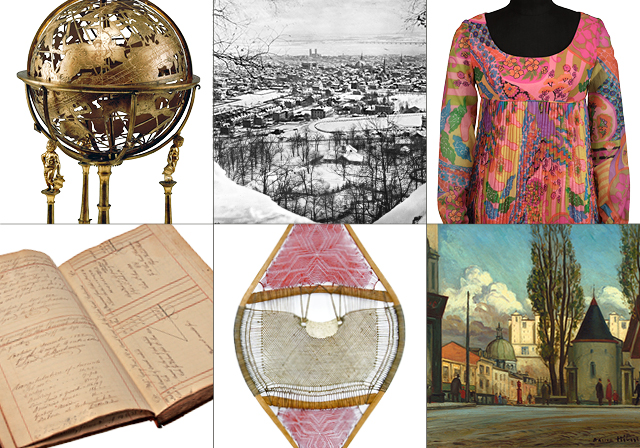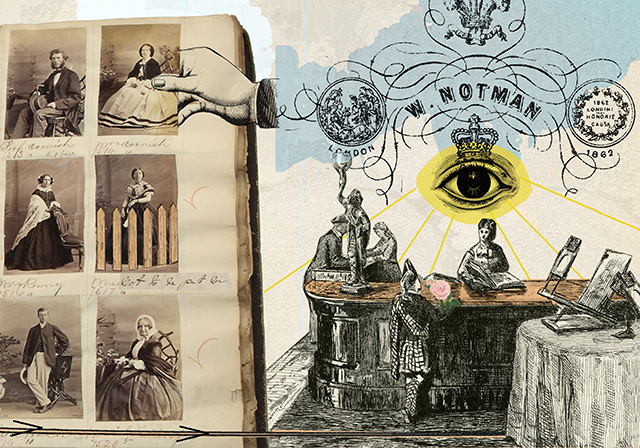Collections and Research

Donating to the collections – FAQ
Thank you for your interest in donating an object, photograph, or document to the Museum!
The Museum continues to selectively build its historical collections to fulfill its mission as a repository for Montreal’s social history. Thanks to our generous donors, the outstanding collections continue to grow.
The Museum’s curators are always interested in learning about objects and their stories.
What do we collect and don't collect
What do we collect?
The Museum selectively enriches the collections with donated objects, photographs and documents illustrating life in Montreal, Quebec and Canada.
We have six major collections, each with a different focus and scope. Learn more about the collections.
To ensure that the Museum makes the best use of its resources in developing and maintaining strong and focussed collections, a formal acquisitions policy is followed for each of our collecting areas.
What don’t we collect?
Documenting, storing, and conserving collections is costly and requires considerable investment. Space for storing collections is limited. For this reason, the Museum often decides not to acquire objects that are offered to us.
Objects that do not relate to Canadian history fall outside our mandate and are acquired only in exceptional circumstances.
Objects that are in very poor condition are costly to care for properly and so are acquired only in exceptional circumstances.
Some objects survive in such large quantities that the Museum is no longer accepting new examples.
Objects that fall under the mandate of another major institution are often more relevant to their collections.
To ensure that the Museum makes the best use of its resources in developing and maintaining strong and focussed collections, a formal acquisitions policy is followed for each of our collecting areas. Learn more about the collections.
How to make a donation proposal
I have something that I think may be of interest. How do I find out?
Contact us at collections@mccord-stewart.ca or 514-861-6701, ext. 1221.
Photographs of the item, anything you know about its history and its condition can help us determine whether it is suitable for the collections.
You will be contacted by a curator, who may ask for further details. The curator will compare the object with the Museum’s current holdings and consider our collecting priorities to see how it may fit into the collections.
If the object is of interest, the curator will wish to see the object and will invite you to the Museum for an appointment.
What information about my donation is important?
Objects are most valuable as historical records when they have documentation, that is, when we know who made or used them, when, and how.
The Museum’s staff will be interested in any other material that can help tell the item’s story, such as related objects, photographs, family stories, and other documents.
Eventually, this information will assist in interpreting the object for research, exhibition, website, and publication purposes.
Can I bring in my object for a curator to look at?
If the object is of interest, the curator will invite you to the Museum for an appointment. A curator is unlikely to be able to see you or give your object proper consideration if you bring it to the Museum without an appointment.
Can I mail or drop off my donation for a curator to look at?
Please do not drop off your donation. We want to make sure that your gift is properly identified and cared for from the moment it enters the Museum.
A member of our curatorial staff will make an appointment with you when ready to receive your object. A receipt for the deposit of objects is issued whenever pieces enter the Museum.
Sending photographs by e-mail prior to making an appointment is especially helpful; the curator will be able to give you an opinion as to the interest of your items.
Acquisition procedures
How are decisions made?
To ensure that the Museum makes the best use of its resources in developing and maintaining strong and focussed collections, a formal acquisitions policy is followed for each of our collecting areas. Learn more about the collections.
Any object we acquire must meet the following criteria:
- It must relate to Canadian history and, usually, Montreal’s history.
- It must fit within our mandate and the scope of the corresponding collection.
- It must be in sufficiently good physical condition that we are able to properly store and care for it in the long term.
We are selectively looking for objects with historical significance. We consider an object’s rarity—are there few or many such objects in circulation? Sometimes an everyday object from the past is very rare today, or an object that was exceptional in its own time survives in great numbers. We
also consider its provenance—what information is known about the object’s particular history? What marks or labels are found on the object itself?
Ownership of copyright and the sensitive nature of certain materials may also factor into the curator’s decision.
Will you take everything I offer?
We appreciate all offers of donation to the Museum.
Documenting, storing, and conserving collections is costly and requires considerable investment. For this reason, the Museum often decides not to acquire objects that are offered to us.
Like all museum institutions, we have procedures in place to ensure we acquire only the material most relevant to our mandate. Our decision to acquire must account for limited storage space, duplication of objects in the collections, and the condition of the piece offered.
What happens once I leave my objects at the Museum?
A receipt for the deposit of objects is issued whenever objects enter the Museum.
The curator will decide whether or not your gift will be recommended to the Acquisitions Committee.
Before making this decision, the curator may decide to keep the object for a few days to facilitate research and comparison with other objects in the collections. You will then be asked to schedule a second appointment in the event that your object is returned to you. This appointment will be canceled if it is decided to recommend the acquisition of your donation.
Both an internal committee and the external Acquisitions Committee meet twice a year to review the curators’ recommendations.
If the acquisitions Committee accepts the curator’s recommendation, you will receive a Deed of Gift, which you must sign to transfer legal ownership to the Museum. The Deed of Gift certifies that the item is yours to give, and that you are donating it without requiring any special conditions for it.
If you have requested a tax receipt, the value will be indicated on your Deed of Gift. The receipt will be mailed to you at the latest the following February.
What is the Acquisitions Committee?
An external Acquisitions Committee meets twice a year to review the curators’ recommendations for acquisitions. The Committee makes the final decision about whether the Museum will acquire an object. The Committee reports to the Museum’s Board of Trustees.
How long does the process take?
The Acquisition Committee meets twice a year to review the curators’ recommendations for acquisitions. Expect to wait up to 6 to 12 months from the date you leave your donation with us until you receive the formal paperwork.
Tax receipts are issued at the latest in February of the following year.
What if my donation is not accepted?
We appreciate all offers of donation to the Museum.
Unfortunately, the Museum has neither the space nor the funding to look after everything it is offered. Like all museum institutions, it has procedures in place to ensure it acquires only the material most relevant to its mandate.
If your donation is not accepted by the Acquisitions Committee, the curator will contact you and arrange for its return.
Generally speaking, you must come and pick up your item, or leave other instructions for its return at the time you meet with the curator. If you do not want the item back, this information must be given in writing.
Monetary evaluation
Can I get an income tax receipt?
Under the Income Tax Act, the Museum may issue a receipt for income tax purposes for the fair market value of the object you have donated.
When an object is valued at under $1,000, museum staff may carry out an appraisal at no cost to the donor.
For objects valued in excess of $1,000, the Museum requires an outside appraisal, which it must initiate. A receipt for $1000 may still be issued at no cost to the donor, otherwise the fees for an outside appraisal must be assumed by the donor.
The curator will guide you through the process and provide information on your options and any fees involved.
What is fair market value, and how is it determined?
We use the following definition of fair market value provided by the federal government:
The highest price, expressed in terms of money,that the property would bring in an open and unrestricted market between a willing buyer and a willing seller who are both knowledgeable, informed, and prudent, and who are acting independently of each other.
Is my donation eligible for certification by the Cultural Property Export Review Board?
The curator will let you know if your donation has outstanding significance or national importance that make it potentially eligible for certification by the Cultural Property Export Review Board. Certification provides a non-refundable tax credit for the full fair market value of your object. The Curator will discuss the procedure with you, and the Museum may make the application on your behalf once we have formally acquired the object.
Can the Museum purchase my object for fair market value instead of issuing a tax receipt?
No, the Museum cannot purchase your objects because it has no acquisitions budget. We build our collections by donations only. The Museum is grateful to our donors who have made the collections the outstanding historical resource they are today.
I don’t want to donate my object, but I want to know its value. Can the Museum help me?
Museum staff cannot offer financial appraisals or valuations of objects to the general public, in accordance with the International Council of Museums (ICOM) Code of Ethics for Museums.
For a formal written appraisal, we suggest you contact the Art Dealers Association of Canada Inc. or the The Canadian Antique Dealers Association.
If you simply wish to learn the price range of similar objects, we suggest you look at online dealer and auction websites.
Dissemination and recognition
How does the Museum care for my donation?
Documenting, storing, and caring for objects is part of the Museum’s ongoing responsibility and commitment to its collections.
Once an object is acquired, we catalogue it and add it to our collections database. It is housed in a museum-quality climate controlled storage area with limited access.
Learn more about conservation at the Museum.
We greatly appreciate any financial help to meet these expenses and welcome any offers to accompany your gift of an object with funds to help us do our job of preserving it. For more information about monetary donation, inquire with the McCord Museum Foundation.
What recognition will I receive as a donor?
The Museum is grateful to our donors who have made the collections the outstanding historical resource they are today.
You or your family are identified as the donor of your object in our collections database and, unless you specify otherwise, this information is available to all who consult it, through our Archives and Documentation Centre.
When objects are exhibited, the names of donors are acknowledged on exhibition labels in accordance with standard museum practices.
If you wish to be notified in the event your donation is exhibited, let the curator know when you make your donation. Inform the Museum if you change your address.
You may not place special conditions on the way the Museum displays or acknowledges your gift, other than a wish to remain anonymous.
Will the Museum exhibit my object?
Exhibitions are only one way that the Museum disseminates information about its collections. Only a small portion of the collections is ever on display at the Museum at any given time.
We cannot guarantee that any objects donated to the collections will ever be exhibited. Exhibitions are developed thematically, and objects are chosen for the way they relate to an exhibition topic. Sometimes objects are lent to other museum institutions for their thematic exhibitions.
The database record for your object and all the information we have about it is available to anyone who wishes to consult it, through our Archives and Documentation Centre.
Will the Museum put my object on its website?
The McCord Stewart Museum expects to have its entire collections database available on its website in the years to come.
The database record for your object and all the information we have about it is available to anyone who wishes to consult it, through our Archives and Documentation Centre.
How will others learn about my object?
The database record for your object and all the information we have about it is available to anyone who wishes to consult it, through our Archives and Documentation Centre.
Miscellaneous
If I donate my object, can you return it to me, my family, or my heirs, at my request?
Once an object has been acquired for the collections, it becomes the property of the Museum. The Museum may store, display, or otherwise interpret it according to established museum practices.
Transfer of ownership to the Museum is made by a formal Deed of Gift, sent to you once the Acquisitions Committee has accepted your donation. The object then becomes the property of the Museum and cannot be returned.
Can I offer my object as a long-term loan?
The Museum does not accept long-term loans. We prefer to commit our limited resources to the storage and preservation of items that have been formally acquired for the collections.
Are objects ever removed from the collections, and what happens to them?
To ensure that the Museum develops and maintains strong and focussed collections, a formal acquisitions policy is followed for each of our collecting areas. Once an object is formally acquired, it is a time-consuming and costly process to remove it from the collections.
In keeping with best practices for the care and development of collections, the Museum may decide to deaccession, or remove, objects that no longer serve the Museum’s mission or goals. An object may be selected for deaccession because of duplication, poor physical condition, or because a better, more fully documented example has been acquired, or because it does not meet the criteria of the formal Acquisitions policy. Deaccessioning is subject to the approval of the Acquisitions Committee, and is carried out in accordance with the standards of the Canadian Museums Association and the International Council of Museums.
Because of the careful selection process and serious commitment the Museum makes when it acquires a new object, it is highly unlikely your object will be selected for deaccession in the near future. If your object is ever selected for deaccession, international standards for best practices will be followed and your object will be offered to another museum. Information about its deaccessioning will remain in the collections database.
What will happen to my object when the Museum closes for its expansion project?
As of the April 2019 announcement of the Museum’s expansion project, plans for the move of the collections are not yet in place. A collections move is a complex and costly process requiring several years of work. Conserving collections objects for posterity is at the heart of the Museum’s mission. The Museum will take all steps required to ensure the highest standards for collections care during the move. As it plans this significant step in its expansion process, it will follow best practices and benefit from the experience of other institutions. The Museum will provide further details on the expansion as the plans unfold.



